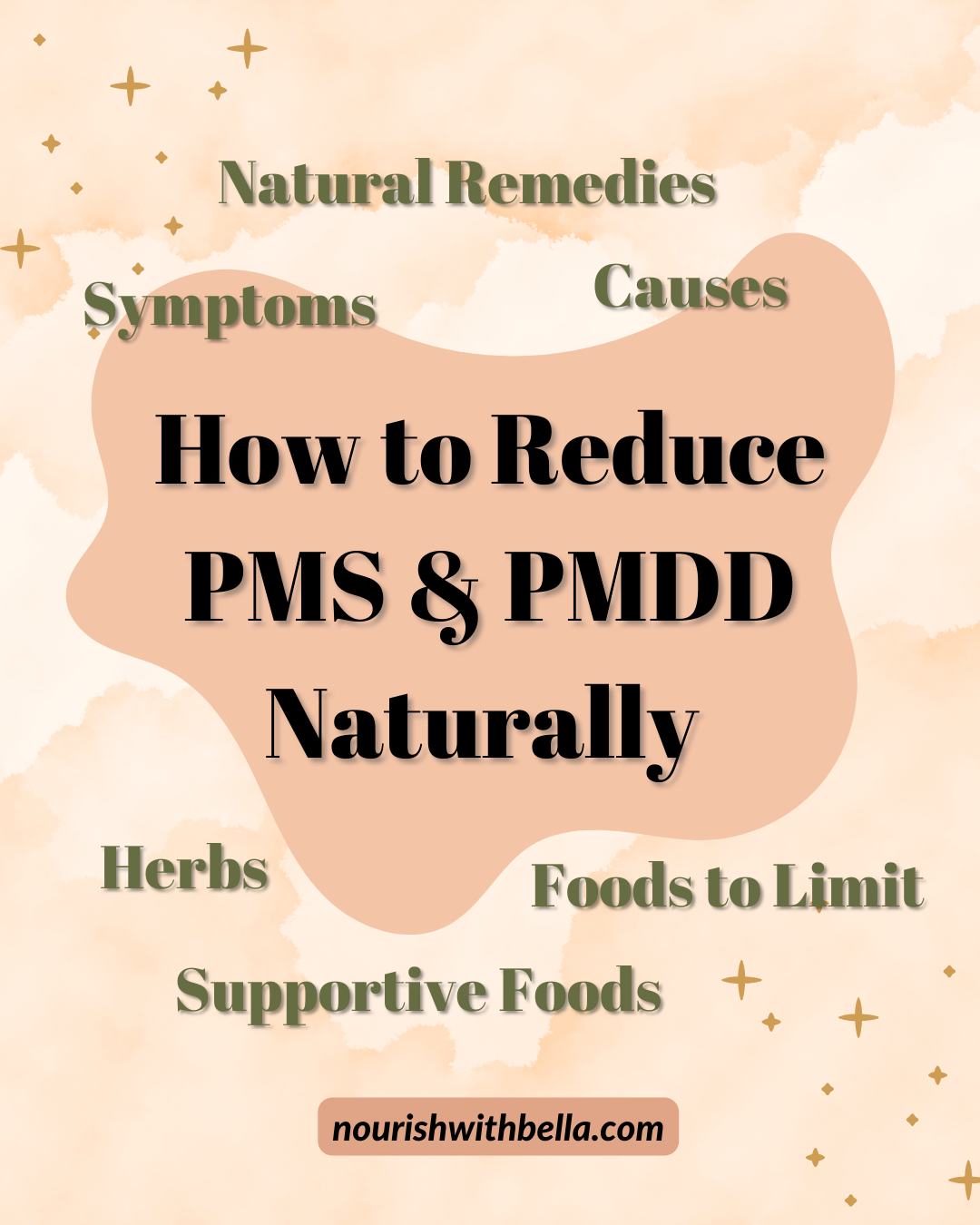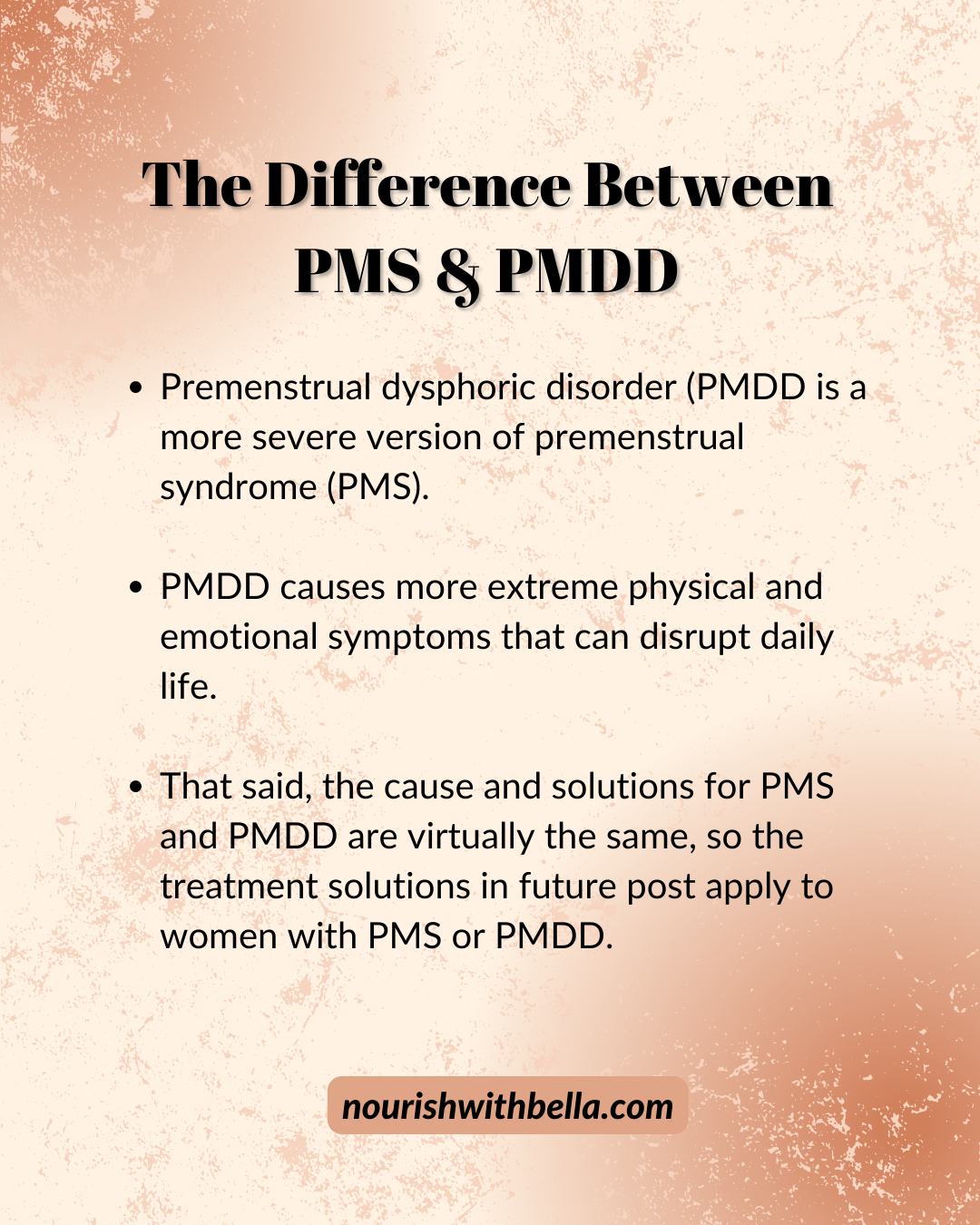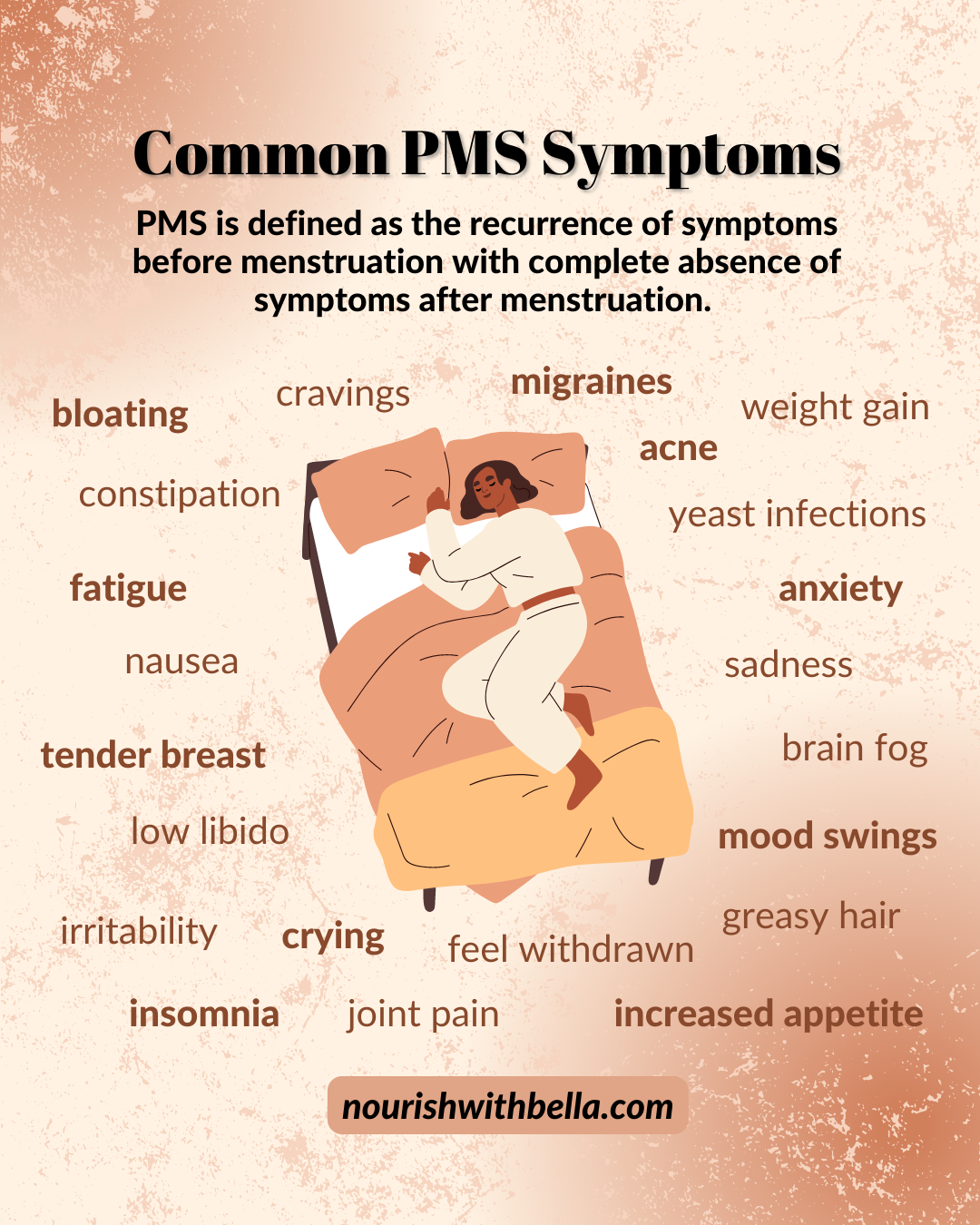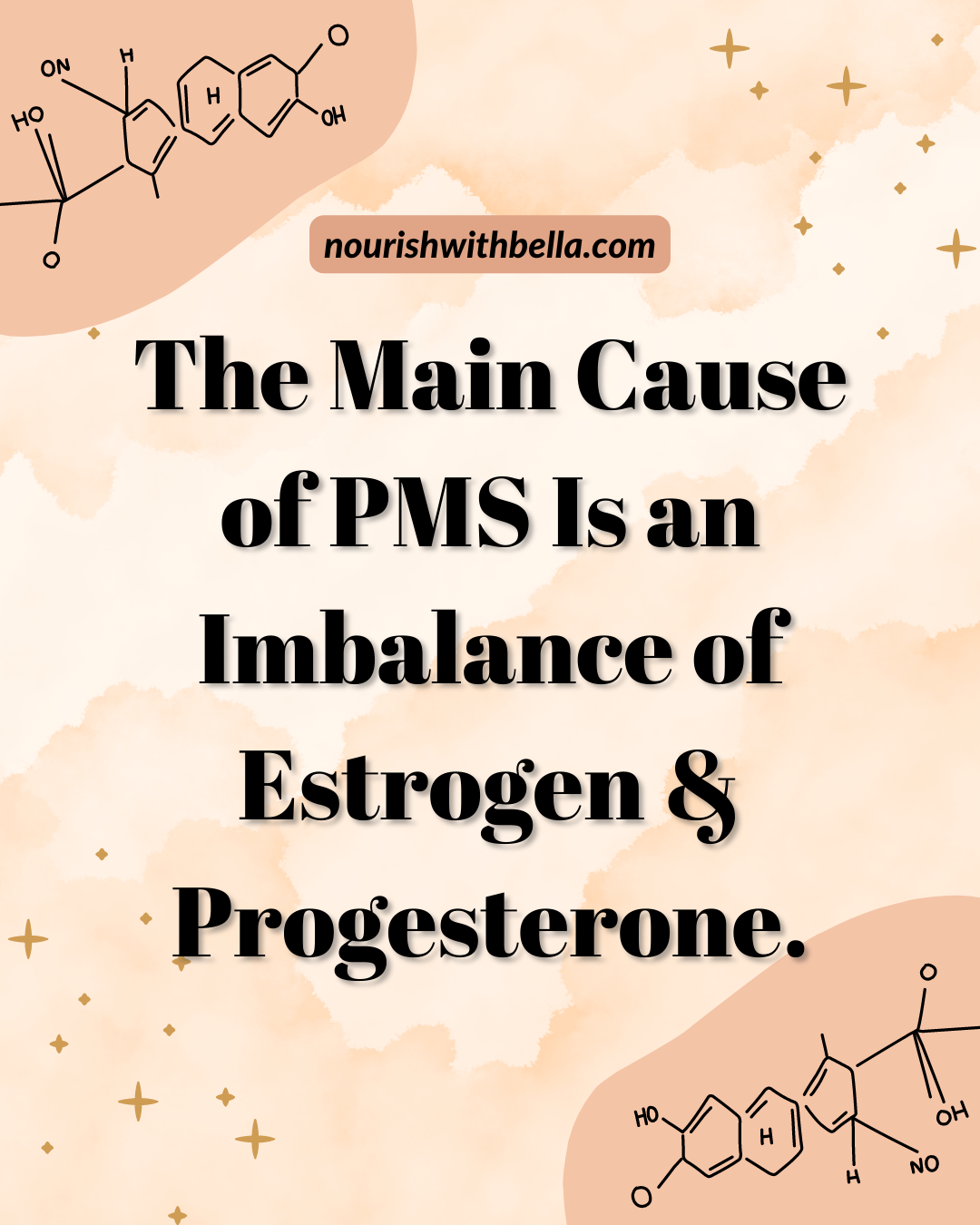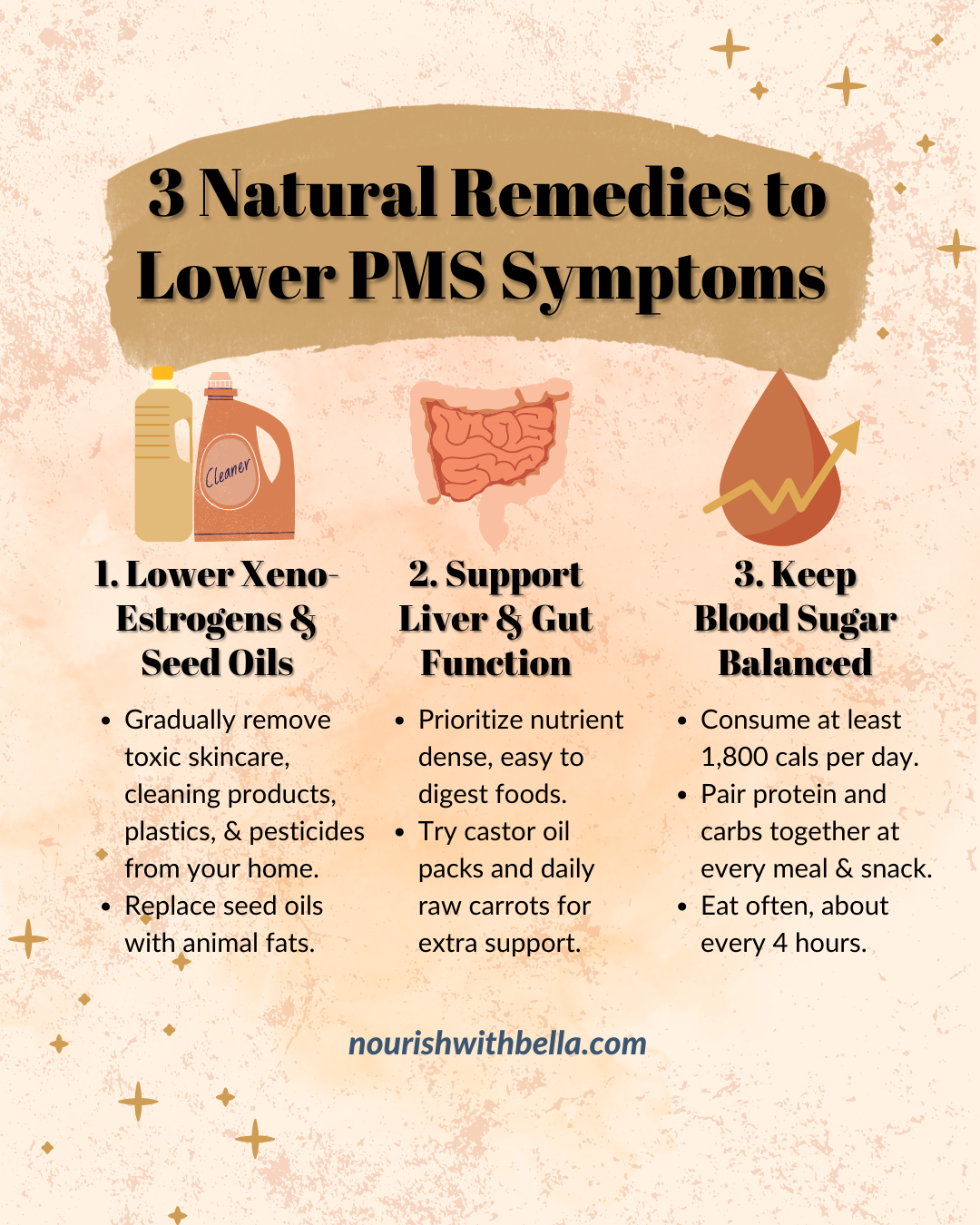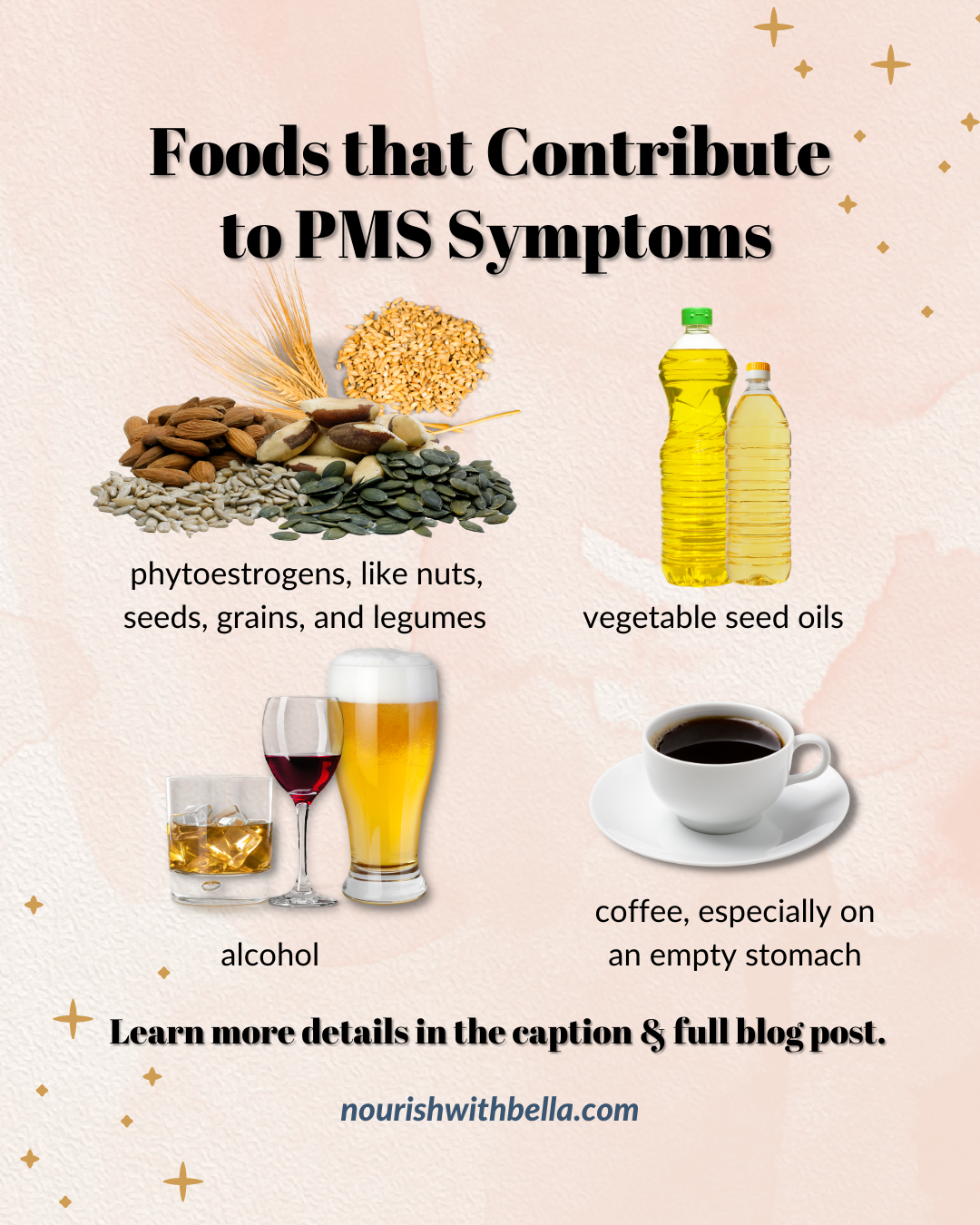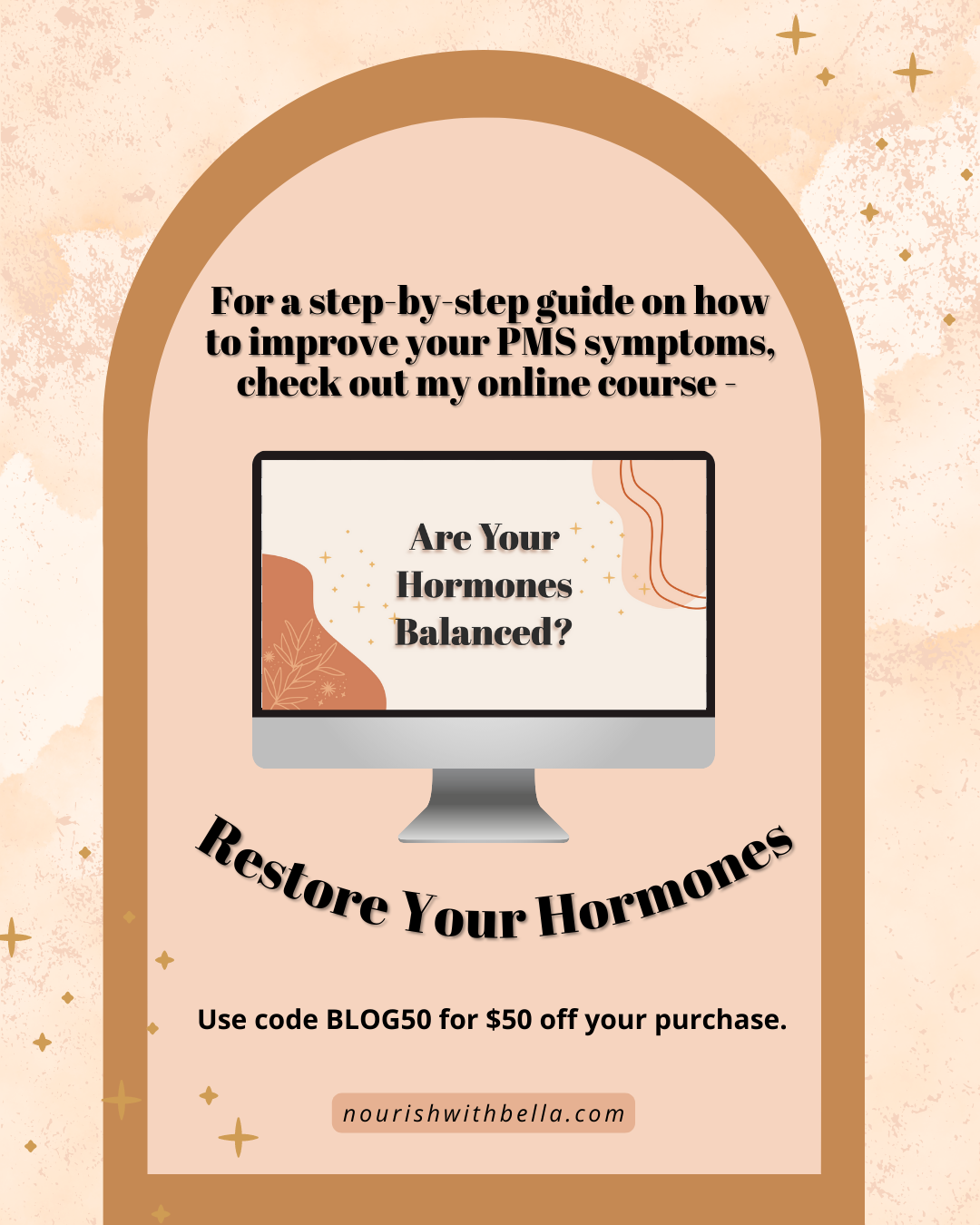How to Reduce PMS and PMDD Naturally
Symptoms, Causes, Natural Remedies, Supportive Foods, Herbs, and Foods to Limit
It’s the week before your period.
You can't stop thinking about an afternoon nap.
People are pissing you off more than normal.
You feel bloated and uncomfortable but also can't poop.
You woke up to a few new acne breakouts.
You're craving all the salty and sugary foods.
Your boobs are annoyingly sore.
All you want to do is lie in bed, cry, and eat chocolate.
You wonder “What the heck is wrong with me?”
Nothing wrong with you. You're not crazy, and your symptoms are not all in your head. You simply are struggling with a hormonal imbalance leading to classic premenstrual syndrome (PMS) symptoms.
Just like you, millions of women around the world suffer from monthly PMS symptoms. In fact 90% of the female population regularly suffers from PMS. (1) Thankfully, solutions exist. There's no reason why any woman has to struggle with these obnoxious symptoms.
In this blog, we uncover and discover the most common PMS symptoms, the difference between premenstrual syndrome (PMS) and premenstrual dysphoric disorder (PMDD), as well as the hormonal imbalance causing PMS. We review and reiterate why allopathic drugs often don't work and suggest three natural remedies, supportive foods and herbs, and harmful foods to limit to finally alleviate your PMS symptoms.
What is PMS?
Premenstrual Syndrome (PMS) is defined as the recurrence of symptoms before menstruation, with complete absence of symptoms after menstruation and occurs in at least two cycles.
Symptoms typically occur between ovulation and menstruation during the premenstrual luteal phase of your cycle.
The Difference Between PMS & PMDD
Premenstrual dysphoric disorder (PMDD) is a more severe version of PMS. PMDD causes more extreme physical and emotional symptoms that can disrupt daily life. Nonetheless, the cause and solutions for PMS and PMDD are virtually the same, so treatment solutions in this post apply to women with PMS or PMDD.
Symptoms of PMS
Over 100 potential symptoms relating to PMS have been clinically reported, but the following remain some of the most common:
Physical Symptoms
bloating
constipation
diarrhea
nausea
breast tenderness
fatigue
low libido
insomnia
headaches/migraines
weight gain
hormonal breakouts
dry skin
oily skin/scalp
eczema
sugar cravings
salty cravings
increased appetite
increased sensitivity to alcohol
night sweats
hot flashes
yeast infections
urinary tract infections
vaginal dryness
lower immune function
Emotional Symptoms
anxiety
depression/sadness
crying spells
irritability
anger
mood swings
irritability
poor concentration
brain fog
feeling withdrawn
low self-esteem
Just because PMS symptoms are commonly suffered does not mean these monthly annoying symptoms are normal. PMS should not control your life. Treatments and lifestyle adjustments can help you manage, reduce, and ultimately eliminate these PMS symptoms.
The Cause: Imbalance Between Estrogen and Progesterone
The underlying cause of PMS is often due to excess estrogen and low progesterone. Symptoms start to occur when estrogen accumulates in the tissues, becoming too high, especially in relation to progesterone.
In a healthy PMS-free cycle, estrogen is the predominant hormone in the first half of the cycle, then has another lesser rise in the second half of the cycle. In the second half of your cycle, progesterone should rise after you ovulate and be higher in contrast to estrogen levels.
However, when you have a hormonal imbalance and struggle with PMS symptoms, you're likely having trouble detoxifying estrogen properly so your estrogen levels stay high and the body can't efficiently create enough progesterone. As a result, progesterone is lower contrasted to higher estrogen, leading to unwanted PMS symptoms. This is why we experience PMS symptoms in the second half of our cycle because that's when the hormonal imbalance takes place.
Hormones are neither good nor bad. Our hormones should naturally work in balance with each other. Let’s look at some of the most common reasons why estrogen levels are typically too high and why progesterone levels are often too low leading to PMS symptoms.
3 Reasons Why Estrogen & Progesterone Imbalances Lead to PMS
When estrogen is in balance, this essential female hormone holds numerous benefits including…
promoting growth and cell proliferation
helping build the uterine lining
making females curvy and plump
increasing vaginal lubrication
improving bone health
aiding better brain function
When progesterone is balanced, we feel incredible. Some of the benefits of progesterone include…
feeling more relaxed and calm
experiencing anti-stress effects
observing anti-aging effects
improving sleep quality
increasing libido
helping regulate blood sugar
increasing and helping utilize thyroid hormone
protecting against breast and uterine cancer
reducing PMS symptoms
However, symptoms from PMS start to occur when estrogen accumulates in the body and progesterone becomes deficient. Here are some of the most common reasons why you may have an imbalance in estrogen and progesterone directly leading to your PMS.
High Stress and Low Blood Sugar
When stress hormones are high from lifestyle factors or from under-eating leading to low blood sugar, estrogen can rise and progesterone is not properly utilized.
Undereating and low blood sugar can directly lead to low progesterone utilization. If you go long periods of time without eating, your stress hormones, especially adrenaline, need to rise in order to compensate and gather energy from your tissues. When adrenaline floods the bloodstream, it blocks progesterone from being utilized by the cells. (2) So even if you're producing enough progesterone, if stress hormones are high, progesterone is not properly utilized and won't bind to the cell receptors. This explains why high stress hormones can eventually lead to an increase in PMS.
One of the best ways to prevent adrenaline spikes and PMS is to lower the stress in your life and plan balanced meals often to keep blood sugar stable, especially during the luteal phase of your cycle.
Another reason why high stress increases PMS symptoms is the fact that stress drives estrogen production. (2) Estrogen can be considered a stress hormone, like cortisol and adrenaline. Estrogen and cortisol are antagonists battling against thyroid hormone and progesterone. If your estrogen and cortisol stress levels are high, you will likely be depleted of thyroid hormone and progesterone, both essential to lower PMS symptoms. So, if your body is under stress from an undernourishing, undereating, and/or over-stressing lifestyle, then you naturally create more estrogen in your body and continue to store estrogen in your tissues leading to PMS.
To learn more about lowering stress hormones, make sure to download my Nourish with Bella free guide, 5 Steps to Reduce Stress Hormones and Restore Your Nourishment.
2. Xenoestrogens
The biggest reason why estrogen levels are on the rise is because of our rapid increase of toxic xenoestrogens, harmful human-made compounds proliferating in our shared environments. Xenoestrogens are synthetic, industrial compounds mimicking estrogen in the body. We’ve never been exposed to so many estrogenic compounds in the history of humankind than we are now in our new toxic modern societies.
Here’s a list of estrogenic compounds contributing to PMS symptoms:
synthetic birth control
pharmaceuticals
phytoestrogens
soy, nuts, seeds, and legumes
vegetable and seed oils
tap water
alcohol
food additives & pesticides
plastics
plasticky store receipts
makeup & skincare products
household cleaners
candles & fragrance
essential oils
mold
heavy metals
endocrine disrupting chemicals
These exogenous estrogenic compounds add unnecessary estrogenic activity to our bodies, leading to PMS symptoms. Purchasing non-toxic versions of these products, like organic foods, clean beauty products, and non-toxic candles, in addition to reducing or eliminating certain xenoestrogens, like birth control, alcohol, and plastics would likely reduce your PMS symptoms. You can use the Think Dirty app or the EWG Healthy Living App to find non-toxic household products available to you.
3. Poor Detoxification
Not only do we add to too many estrogen-like substances in our bodies, but we’re also struggling to properly detoxify estrogen from our bodies.
Here are some reasons why many of us struggle with poor detoxification:
Not eating enough animal protein or carbohydrates. Glucose (carbs) and protein are essential for the two phases of liver detoxification. Without enough sugar (glucose) and protein, our liver becomes sluggish and estrogen starts to accumulate and continues to circulate throughout the body, leading to PMS symptoms.
Depleted in minerals and vitamins, especially B vitamins found in animal proteins. These B vitamins accelerate liver detoxification, eventually reducing and alleviating PMS symptoms.
Constipation, slow bowel movement also lead to a buildup of estrogen within the body. Defecation is our one-and-only way to excrete estrogen from the body. If you’re not pooping daily, you’re not detoxifying estrogen, which eventually could lead to PMS symptoms.
Typical Allopathic Approach for PMS
Allopathy refers to physicians using drugs, radiation, or surgery to treat illnesses and diseases. The following drugs are typical prescriptions given to women suffering from PMS or PMDD symptoms. (3) These pharmaceuticals only mask the symptoms of PMS and not address the root cause of this chronic ailment. Drugs only cover up PMS symptoms; they never completely alleviate the hormone imbalance.
(This information is for educational purposes only. Please talk to your trusted medical professional before going off any of these medications.)
Hormonal Birth Control
Synthetic birth control does not regulate your cycle or actually resolve your PMS. These drugs just suppress your symptoms. Taking hormonal birth control might seem to lower your PMS symptoms, but never actually resolving the root cause of the problem, high estrogen levels. In fact, hormonal birth control actually adds synthetic estrogen to the body, and once you get off birth control, your PMS symptoms often come back, typically even worse than before. Read this Nourish with Bella blog post All About Hormonal Birth Control to learn more about the dangers of hormonal birth control.
Antidepressants
Antidepressants, often prescribed for patients struggling with anxiety, depression, irritability, and mood swings, common symptoms related to PMS, cover up the problem, not resolve it, making women feel like medication is the only solution.
Diuretics
Diuretics work by helping you shed extra water weight, often through peeing it out. This might help with PMS bloating, but it doesn't solve the root problem. Diuretics also can further lower potassium levels and deplete you from other essential minerals, leading to a further undernourished body, never actually addressing how to eventually alleviate the root cause. Instead of relying on synthetic diuretics, working towards increasing progesterone levels, which is a natural diuretic, is a much better solution.
Spironolactone
Spironolactone is another drug often prescribed to those suffering from PMS, touted to reduce acne, irritability, depression, swelling, breast tenderness, and craving salty or sugary foods. However, similarly to diuretics, over time, spironolactone can lead to deficiencies in calcium, magnesium, and sodium, all crucial for reducing PMS and improving overall health.
3 Natural Remedies for PMS
Now that we’ve established the main causes of PMS, high estrogen and low progesterone levels, let’s learn about certain reliable remedies to help you eliminate, reduce, and manage these PMS symptoms.
Lower xenoestrogens and seed oils.
One of the most effective ways to reduce PMS symptoms is by reducing exogenous estrogens, including xenoestrogens, especially vegetable seed oils. As mentioned earlier, many xenoestrogenic products, like skincare, hair care, and household cleaning products add unnecessary estrogen to the body, often contributing to PMS symptoms. Whenever possible, choose non-toxic beauty and household products to lower your estrogen exposure.
Also, reducing your vegetable oil intake can greatly reduce your PMS symptoms. Vegetable oils mimic estrogen in the body, leading to PMS symptoms. Our modern food system predominantly uses vegetable seed oils in most ultra-processed foods. Eliminating these harmful oils from your foods can be overwhelmingly difficult and virtually impossible, but do the best you can and limit them when possible. If you're looking for recipes without any vegetable seeds oils, check out my meal guide and recipes PDF that’s part of my online course Restore Your Hormones.
2. Support gut and liver detoxification.
A damaged gut and sluggish liver creates an ideal environment for PMS. By supporting proper gut motility and improved liver function, you can eventually overcome your PMS symptoms.
One way to support proper gut and liver function is through castor oil packs. Castor oil packs improve lymphatic drainage, support detoxification pathways, improve bowel movements, and decrease inflammation, all which can improve PMS.
Another way to support proper gut and liver function is eating raw carrots daily. Raw carrots contain a specific fiber that binds estrogen in the gut and safely removes it from the body, lowering excess estrogen.
Lowering estrogen in the gut and not allowing it to recirculate also puts less pressure on the liver to continually excrete estrogen. This gives the liver more energy and resources to detoxify other metabolites and improve blood sugar balance.
3. Keep your blood sugar stable by eating more consistently.
If you want to highly prioritize only one action to reduce PMS symptoms, eat more consistently. Like mentioned earlier, when you go long periods of time without eating, your stress hormones must rise in order to compensate and keep your blood sugar stable. The problem with high stress hormones, like too much adrenaline present in the blood, blocks progesterone from being utilized. So, even if you're producing enough progesterone, it’s not usable if adrenaline is present.
By eating more consistently, about every four hours at least, you can prevent this rise in stress hormones, and therefore, allow progesterone to bind to the cell, reaping its numerous benefits and preventing PMS symptoms.
Nourishing Foods for PMS
Animal Proteins
Your liver requires a large amount of bioavailable, usable, animal protein in order to properly function. We know that strong liver function is essential to keep PMS symptoms at bay. Consuming at least 100 grams of protein daily can help support proper liver function, which improves estrogen metabolism, promotes progesterone production, and therefore lowers PMS.
Starchy Carbs
Starchy carbs often get a bad wrap. However, when it comes to PMS, starchy carbs can help to keep blood sugar stable. Since they contain long chains of glucose, they help to prevent a drop in blood sugar, which keeps stress hormones low and progesterone high, preventing PMS symptoms.
The best sources of starchy carbs are rice, white potatoes, and sourdough bread. Just make sure to always pair your starchy carbs with a protein source to prevent a high spike in blood sugar.
Bone Broth
Bone broth contains many nutrients, especially magnesium and calcium, both shown to prevent PMS symptoms. Also, glycine, an amino acid in bone broth, has an anti stress and calming effect, which can help with irritability and improve sleep.
Fruit
Fruits contain natural sugars, gentle fibers, and many minerals. The natural sugars help to prevent a rise in stress hormones. The gentle fibers help to bind and excrete excess estrogen. Minerals help to keep the body nourished. All can reduce and alleviate PMS symptoms.
Quality Fats
Fats are essential to all hormones, including progesterone. Women who consume low-fat diets often struggle more with hormonal imbalances. Therefore, it's crucial to consume stable, saturated fats, like ghee, butter, animal fats, and coconut oil. These saturated fats are less likely to oxidize in the body, while also improving progesterone production.
Foods to Limit If Struggling with PMS
Phytoestrogens
Foods like nuts, seeds, grains, and legumes all contain phytoestrogens. These phytoestrogens can mimic estrogen in the body increasing the risk for PMS symptoms. If you enjoy eating these foods, aim to consume soaked and/or sprouted versions, which help break down and remove most of the phytoestrogenic compounds.
Seed Oils
Just like other xenoestrogens, seed oils mimic estrogen in the body, increasing the amount of estrogen and contributing to PMS. By limiting these seed oils whenever possible, you can greatly reduce your estrogen levels and therefore PMS symptoms.
Alcohol
Alcohol is inherently estrogenic. By limiting alcohol consumption, especially during your luteal phases, you can lower your exogenous estrogen exposure, and therefore reduce your risk of PMS symptoms.
Coffee, especially on an empty stomach.
Drinking coffee away from food can increase stress in the body. As mentioned earlier, high stress hormones can block the utilization of progesterone, leading to PMS symptoms. If you love your morning coffee, aim to drink it with or after a meal to prevent a spike in stress hormones.
Best Supplements for PMS
Magnesium
In our high stress modern world, most women burn through magnesium stores relatively quickly. Since we know that stress can increase PMS symptoms, increasing your magnesium stores to counteract stress can often improve PMS. Certain foods like bone broth, raw dairy, and cooked leafy greens contain decent amounts of magnesium. However, since most of us burn through magnesium quickly, it can be helpful to supplement.
My favorite brands for magnesium are ancient Minerals Magnesium Oil, Pure Encapsulations, and Natural Stacks Magtech.
B Complex
Boosting your B vitamins levels has significantly shown to reduce PMS symptoms, especially depression. B vitamins are also essential for proper liver function, which improves estrogen detoxification.
Certain foods contain high levels of B vitamins include liver, oysters, muscle meat, dairy, bee pollen, and nutritional yeast. If you're consuming adequate amounts of these foods and still experiencing PMS symptoms, you can consider taking a B complex supplement.
My favorite brands of B complex are Thorne, Ortho Molecular, and Integrative Therapeutics.
Vitamin E
Vitamin E is a powerful antioxidant and anti-estrogenic, reducing the negative impacts of excess estrogen within the body. Vitamin E also acts similar to progesterone in the body, so both vitamin E and progesterone help to balance and regulate estrogen. You can increase your vitamin E levels through foods such as avocados, mango, kiwi, bell peppers, and soaked/sprouted nuts and seeds, or consider supplementation.
My favorite brands of vitamin E are Unique E, Thorne - Ultimate E, and PUFA protect.
Herbs for PMS
Red Raspberry Leaf
Red raspberry leaf is traditionally used to support female reproductive health, from reducing PMS, especially bloating, to regulating periods and supporting fertility. Drinking red raspberry tea daily, especially during the luteal phase, may reduce PMS and improve overall reproductive health.
Nettle
Nettle is a super mineral rich herb, which can especially help with energy and fatigue during the luteal phase. Nettle also supports liver function, especially estrogen detoxification and reduction of water retention, which can drastically reduce PMS symptoms.
Dandelion
Dandelion is well known for its detoxifying properties, improving liver function, and accelerating detoxification, aiding in eliminating excess estrogen. Supporting proper liver function likely results in lower PMS symptoms.
Chamomile
Chamomile contains numerous benefits like anti-anxiety, anti-depressant, and antispasmodic properties, improving liver function, and lowering stress. Consuming chamomile during the luteal phase can improve numerous PMS symptoms from anxiety and mood swings as well as reducing cramping.
To reiterate, just because PMS symptoms are common does not mean they’re normal. PMS symptoms should not control your life. You should be in control of your PMS symptoms, and you can.
If you're interested in a more in depth, step-by-step guide to balancing estrogen and progesterone, check out my online course Restore Your Hormones. In the course, we focus on balancing estrogen, progesterone, thyroid, and stress hormones. The course includes five modules with over nine hours of informational lessons, meal plans and recipe guides, and a six-phase, step-by-step guide to help you improve your hormone balance. You can use the code BLOG50 for $50 off your purchase.
I hope you find the information, remedies, foods, and herbs helpful on your PMS healing journey. If you have any questions concerning this post, please comment below or send me an email at bella@nourishwithbella.com

